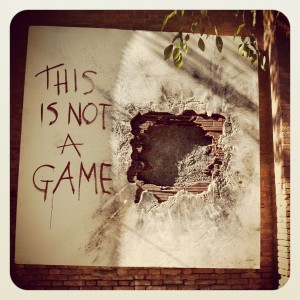Marshall (1950) defines citizenship as being composed of civic, political and social elements, which as Sassen (2002, p.7) describes, form a legal status entailing “the specifics of whom the state recognizes as a citizen and the formal basis for the rights and responsibilities of the individual in relation to the state”. Recently Sassen (2008) has identified what she calls a certain “denationalizing” transformation in the institution of citizenship that occurs as a result of changes in the territorial and institutional organization of state authority and globalization (Sassen, 2008, p.7). In other words, as the conditions in which citizenship is embedded change, so does the institution itself. Sassen (2008, p.281) suggests that the global city is a key driver of this change, a “partly denationalized space that enables a partial reinvention of citizenship as a practice and a project”. In place of questions of nationality the practices and informal politics of citizenship can move toward the enactments of a large array of particular interests or “rights to the city”.
In this context, one particular interest or civil rights issue that a many citizens living in cities face is air pollution, which is the focus of the Smart Citizen environmental monitoring project (Fab Lab Barcelona, Institute for Advanced Architecture of Catalonia). The Smart Citizen kit is an open-source environmental monitoring platform consisting of arduino-compatible hardware, a data visualization web API, and mobile app to measure localised environmental pollution (CO, NO², temperature, humidity, light intensity and noise levels) (Waag, 2014). The citizen or perhaps Smart Citizen in this project is potentially able to contest traditional sources of environmental data and by sharing information online gain wider global support for a local issue. Aligning with Sassen’s (2008) critique, this project certainly taps into a contemporary version of citizenship, that identifies with a particular issue and asks questions of citizenship’s traditional national boundaries. The challenge for the project is to remove the boundaries in terms of cost and technological proficiency that may stand in the way of making this a democratic endeavour.
Marshall, T., 1950. Citizenship and Social Class. In: J. Manza. and Sauder, M. ed. 2008. Inequality and Society. W.W. Norton and Co.: New york.
Sassen, S., 2002. The Repositioning of Citizenship: Emergent Subjects and Spaces for Politics. Berkeley Journal of Sociology, [online] Available at: <http://transnationalism.uchicago.edu/RepositioningCitizenship.pdf> [Accessed 27 April 2014].
Sassen, S., 2008. Territory, Authority, Rights: From Medieval to Global Assemblages. New Jersey: Princeton University Press.
WAAG Society, 2014. Projects: Smart Citizen Kit. [online] Available at: <https://waag.org/en/project/smart-citizen-kit> [Accessed 27 April 2014].
Image source: http://waag.org/en/project/smart-citizen-kit
Links:
Press reports of the project:
http://techcrunch.com/2013/05/19/acrobotics-wants-to-kickstart-smarter-cities-with-its-smart-citizen-environment-sensors/
http://www.newscientist.com/article/dn25393-a-smart-way-to-get-personal-with-the-future.html#.U1pizsc2w4M
More about the project from an initial trial in Holland:
https://waag.org/en/blog/smart-citizens-waag
https://waag.org/en/project/smart-citizen-kit
Interview with Saskia Sassen discussing contemporary citizenship:
http://citsee.eu/interview/%E2%80%98artisans-incorporation%E2%80%99-interview-saskia-sassen
Press report about contested air pollution data in Beijing:
http://blogs.wsj.com/chinarealtime/2014/04/14/beijings-bad-air-days-finally-counted/
What is a Smart Citizen?Hill, D,. 2013. Smart Citizens Make Smart Cities. In: Hemment, D. & Townsend, A., 2013. Future Everything publications: Smart Citizens. Available at: <http://futureeverything.org/publications/smart-citizens/ > [Accessed 27 April 2014].









